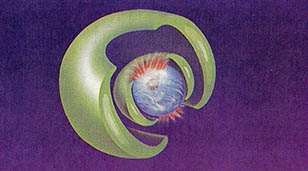지난 달, 태고의 새로운 괴물이 발견되었다고 발표되었다. 사우스 캐롤라이나주 찰스톤에 공항을 세우기 위해 땅을 파던중에 오늘날 펠리칸 새의 먼 조상뻘이 되는 바다새의 두개골과 뼈가 약 3천만년 된 암석에서 발견되었다. 이 옛 동물은 뼈 이빨을 가진 새라는 뜻의 '수도돈토른'이라 불리우게 되었다.
지금까지 존재하는 가장 큰 바다새인 방랑하는 신천옹과 이 괴물을 비교해 보라. 신천옹의 날개 폭이 11피트인데 비해서, 옛날의 펠리칸은 아마 19피트에 이르는 날개폭을 가지고 있엇을 것이다.
그러나 이것은 지금은 멸종된 독수리-이제껏 생존했던것 중 가장 큰 육지새-가 25피트나 되는 날개길이를 가졌다는것을 고려한다면 별것이 아니다. 지금까지 알려진 가장 큰 '프테로사우루스'(6천5백만년 전 또는 그 이전에 살았던 날으는 도마뱀)는 40피트에 이르는 날개폭을 가졌다.
이런 생물체들이 어떻게 날 수 있었는가 하는 문제가 있다. 오늘날 살아있는 가장 무서운 새 '코리 들칠면조'(능에과의 새)는 무게가 약 30파운드 나가는데 어렵게 난다. 신천옹은 그 날개폭에도 불구하고 가벼워서 22파운드를 넘지않을 것으로 보이지만 이륙하는 것이 힘든다. 그것들은 적극적으로 날지 않고 날개 근육보다는 상승 기류를 이용하여 공중으로 치솟는데 대부분의 시간을 보낸다.
그러나 멸종된 펠리칸은 약 90파운드에 이를 것으로 추정되고, 그 뼈대 구조상 사람들은 단지 그것이 날개를 올렸다 내렸다 할 수 있을 뿐이지 앞으로 나아갈 수 있는 날개짓은 할 수 없었으리라고 생각한다. 의심할 바 없이 펠리칸은 단지 위로 치솟아 오를 수 있었을 뿐이다. 그러나 그 경우 어떻게 펠리칸은 처음에 비상할 수 있을만큼의 높이까지 이를 수 있었을까? 어떻게 이륙하였는가? 그것은 수수께끼이다. 또 이것은 멸종한 독수리나 큰 프테로사우르스의 경우에도 마찬가지이다.
또 다른 수수께끼는 왜 옛날에 살았던 동물들은 지금 존재하고 있는 동물들보다 훨씬 더 거대하였는가 하는 것이다. 지금까지 살아있는 가장 큰 영장류는 저지대 지방의 고릴라로서, 키는 인간만하고 몸무게는 약 4백파운드에 이른다. 그러나 수백만년 전에는 키가 약 9피트에 이르고 무게는 1천파운드에 육박하는 '자이간토피테쿠스' (거대 원숭이)라는 훨씬 큰 종(種)이 살고 있었다.
생존해 있는 가장 큰 육지의 포유 동물은 아프리카 코끼리인데 어깨까지의 높이가 거의 11피트이고 무게는 6톤정도이다. 그러나 2천~4천만년 전에는 거대한 코뿔소(긴 코뿔은 없는)인 '발루키테리움'(발루키스탄 지방의 짐승)이 살았었는데, 어깨까지의 키가 19피트로서 가장 큰 기린만큼이나 컸다. 또 머리에서 꼬리까지의 길이는 28피트이고 무게는 약 20톤에 달했다.
그리고 약 1억5천만년 전에는 '브라키오사우루스'(팔 도마뱀)라 불리우는 거대한 공룡이 살았었다. 이것은 모든 종을 통틀어서 가장 큰 육지동물이었다. 어깨까지의 키가 21피트이고 머리를 40피트 높이까지 뻗게 할 수 있는 긴 목을 가지고 있었다. 이것은 현대빌딩의 4층 창문안을 들여다 볼 수 있는 높이이다. 이것의 몸무게는 약 80톤에 이르는데, 현존해 있는 가장 큰 코끼리보다 13배 정도의 무게이다.
혹은 새를 생각해보라. 오늘날 살아있는 가장 큰 새들은 너무 무거워서 날지 못하지만 어쨌든 잘 해나간다. 타조는 살아있는 새들중에서 기록을 보유하고 있는 새이다. 긴 목까지 합쳐서 땅 끝에서 머리까지의 길이는 8피트이고 무게는 2백80파운드로 시속 40마일의 속력으로 달릴 수 있다.
그러나 몇 세기 전만 해도 뉴질랜드에는 타조와 유사한 '모아'가 살고 있었다. 키는 13피트 무게는 5백파운드나 되었다. '모아'는 가장 키가 큰 새이지만, 몸 무게는 그렇지가 못하다. 1600년대까지도 '코끼리 새' 혹은 '애피오니스'가 마다가스카르에 살고 있었다. 키는 10피트 밖에 안되지만 무게는 1천파운드에 달했다. 이 새의 알은 알 중에서 가장 커서 2 1/3 갤론의 용적을 갖고 있었다. 이것은 타조알의 7배에 해당된다.
또는 곤충을 생각해보라. 길이가 7인치 무게가 3 1/2온스되는 풍뎅이(딱정벌레)가 있다. 그러나 3억년 전에는 길이가 1피트 날개너비가 2 1/4피트 되는 잠자리가 있었다.
그러면 생물체는 퇴화하고 있는가? 나는 그렇게 생각하지 않는다. 나는 결국에는 작고 재빠른 생물이 크고 느린 것보다 더 낫다는 것이 판명된 것이라고 생각한다. 이외에, 오늘날에도 놀라운 생물체는 있다.
요컨대 모든 시대를 통해서 가장 큰 짐승이 오늘날에도 살아있는 것이다. 그것은 푸른 고래이다. 그것의 길이는 90피트 무게는 1백30톤으로 제일 큰 공룡보다 길이나 크기에 있어 2배가 된다. 그리고 높이가 4백피트나 되는 미국의 삼나무보다 더 큰 나무는 없었다. 그리고 가장 무거운 나무도 오늘날 존재한다. 세쿼이아 나무가 그것으로 제일 큰 것은 6천7백톤이 나간다(제일 큰 고래의 50배).
마지막으로 모든 시대를 통해 가장 지능이 높은 종, 철학 과학 기술 예술 문학을 발전시킬 수 있는 유일한 능력을 가졌으며 불을 사용하고 전기를 이용하며 달에 착륙한 종이 있다. 그것은 호모사피엔스이다. 지질학적 시간으로 계산하자면, 우리 인간은 '어제'부터 존재한것에 불과하다.
Last month it was announced that new monster of the past had been discovered. A skull and other bones of a sea bird, distantly related to modern pelicans, were discovered in some 30 million-year-old rocks during excavations for an airport in Charleston, S. C. The ancient animal was dubbed "pseudodontorn," the bony-toothed bird.
Compare this monster with the largest sea bird now alive, the wandering albatross. While the albatross has a wingspread of 11 feet, the ancient pelican had one of perhaps as much as 19 feet.
Even this pales, however, when we consider that a now extinct vulture, the largest flying land bird known to have existed, had a wingspan of up to 25 feet. The largest known pterosaurs(flying reptiles that lived 65 million or more years ago) had wingspreads of up to 40 feet.
There is a question as to how these creatures could possibly fly. The heaviest flying bird alive today, the Kori bustard, weighs 30 pounds or so and flies with difficulty. Albatrosses, for all their wingspread, are lighter, weighing perhaps no more than 22 pounds, and they have difficulty taking off. They spend most of their time in the air soaring, rather than actively flying, taking advantage of rising air currents rather than their wing muscles.
The extinct pelican, however, may have weighed as much as 90 pounds and from its bone structure, one suspects that it could only move its wings up and down, but couldn't flap them to get forward thrust. Undoubtedly, the pelican could only soar, but in that case how did it get high enough to soar in the first place? How did it take off? It's a puzzle. That goes for the extinct vulture and for the large pterosaurs, too.
Another puzzle is why animals that existed in the past were so much larger than any now living. The largest living primate is the lowland gorilla, which is as tall as a man and may weigh up to 400 pounds. A few million years ago, however, there lived a still larger species, Gigantopithecus ("giant ape"), that was up to nine feet tall and might have weighed close to 1,000 pounds.
The largest land mammal now alive is the African elephant, which stands nearly 11 feet tall the shoulder and can weigh up to six tons. However, about 20 to 40 million years ago, there lived a giant rhinoceros(without nose horns), the Baluchitherium ("beast from Baluchistan"), which stood nearly 19 feet tall at the shoulder, the height of the tallest giraffe. It was up to 28 feel long from head to tail and weighed at least 20 tons.
And about 150 million years ago there lived a giant dinosaur called "Brachiosaurus" ("arm lizard"), which was the largest land animal of any kind. It stood 21 feet tall at the shoulder and had a long neck that could lift its head as high as 40 feet in the art, tall enough to look into the fourth-story window of a modern building. It might have weighed as much as 80 tons, 13 times as much as the largest elephant alive today.
Or consider birds. The largest birds alive today are far too heavy to fly, but they can do well anyway. The ostrich holds the record for living birds. Its head, atop its long neck, can be eight feet off the ground. It can weigh up to 280 pounds, and it can run at speeds of up to 40 m.p.h
Yet only a few centuries ago, there lived giant ostrich-like moas in New Zealand that held their heads at heights of up to 13 feet and weighed up to 500 pounds. This is a height record, but not a weight record. Up to the 1600s, the "elephant bird," or "Aepyornis," was still alive in Madagascar. It stood only 10 feet high, but it weighed nearly 1,000 pounds. It had the largest egg known, with a capacity of 2 1/3 gallons, seven times that of an ostrich egg.
Or consider insects. There are beetles up to seven inches long, and some that weigh as much as 3 1/2 ounces. But about 300 million years ago, there were dragonflies with bodies over a foot long and a wingspread of up to 2 1/4 feet.
It life degenerating, then? I don't think so. I think that in the long run, it just turns out that small and nimble works better than large and clumping. Besides, we have our own wonders today.
After all, the largest animal of all time is alive today. It is the blue whale. It can be up to 90 feet long and weigh up to 130 tons, twice that length and size of the largest dinosaur that ever lived.
Nor is it likely that there were ever any taller trees than the redwoods of today, which reach heights of 400 feet or so.
And the most massive trees are also alive today.
These are Sequoia trees, the largest of which may weigh up to 6,700 tons (50 times as heavy as the largest whale).
Finally, the most intelligent species of all time, the only one capable of developing philosophy, science, technology, art, literature, the only one to make fire, wield electricity and stand on the moon, is alive today. It is Home sapiens, and, as geology counts time, we only came into existence yesterday.
(c) 1987, Los Angeles Times Syndicate

















